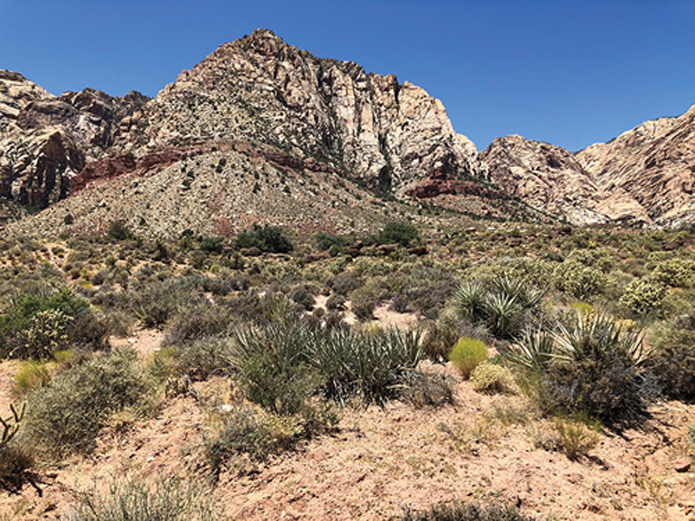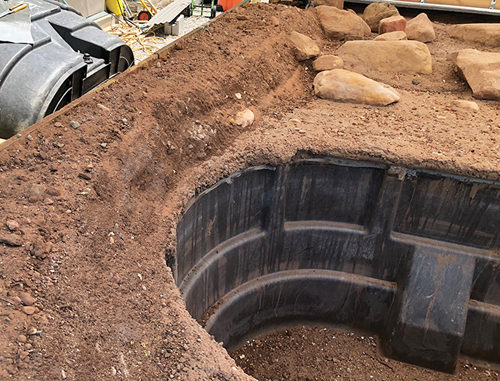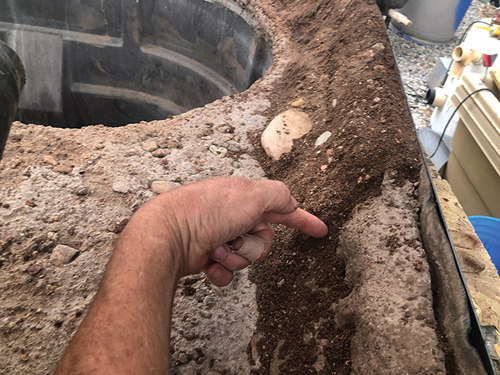
A living pond is an artificial body of water with the functional capability of supporting aquatic life. The proper function of a living pond has little to nothing to do with its aesthetic makeup. The visual appearance of a pond relies upon a combination of how well it fits into the surrounding space and what the client desires.
Many contractors and DIY-ers have the talent to build beautiful waterfalls and streams. Given a great deal of artistic license, those who view a water feature know it’s not a natural environment — it’s created. In that light, we’ve coined the term “naturalistic.”
The Edge Treatment
When an owner, landscaper, landscape architect or contractor sits down to design a pond, they reference building materials that are familiar and at their disposal. Rocks, boulders, plants and some landscaping materials are the choice in a natural landscape pond; brick, tile and flagstone-shaped materials are the choices in a formal design.
Doesn’t this beg the real question, “What’s the edge going to look like?” Isn’t the “edge treatment” what most aesthetic design parameters revolve around? The edge treatment serves as the initial appearance of a water feature. How well a builder deals with the edge is indicative of the quality of his or her work. Even a stream bed with strategically placed spills and carefully selected stones for flow is defined by the treatment of its edge.Part of the job of the edge treatment is to secure the waterproofing membrane. Formal edged ponds have the liner or polyurea secured under the top cap with a slight overhang of a couple of inches to hide the narrow band of exposed waterproofing along the top just above the waterline. Sometimes the inside edge, which is just under the top cap, is covered with vertical flagstone or tile for a more finished look.
In naturalistic landscape ponds, the rubber liner or polyurea is secured in place with block or colored, exposed or sanded concrete secured in place with stones and boulders. Eric Triplett (“The Ponddigger”) sometimes uses a system where the liner is brought up above water level a couple of inches and then folded back down on the outside before it’s trimmed and backfilled with soil, rocks, boulders and plantings on each side. This allows adjustment over time with the extra folded liner. Many times, he plants on both sides of the liner with no concrete, making the liner disappear and creating a more natural look. This method allows for future adjustment with the additional liner when plantings push and manipulate the liner over time.
Added Difficulty

Formal ponds don’t require the illusion of a natural environment. Naturalistic ponds are a different story. When we travel into the wilderness, we notice that the edges of streams, ponds and lakes are not necklaced with rocks and boulders. There may be tree roots and plants that hide the edges and control erosion, with rocks and boulders scattered here and there — but mostly it’s dirt.
In the past, my solution was putting a mixture of colored concrete and aggregate between mindfully placed stones. No. 12 sand is thrown on top to create a sanded look. After it cures, the surface gets acid washed, and what’s left is a thin layer of sand stuck to the surface, with the other aggregates and colored cement in the background. It’s a good look, but it still doesn’t look completely natural.
The challenge is how to create the look of dirt or sand with the hardness of concrete. Even concrete will deteriorate over time, as biofilm and algae grow onto and into it. The problem is the transitional space from just below the water level to just above the water level. If only we could put dirt all the way down to a shelf and it would stay there without being washed away, it would make for an ideal edge.
Over the years, I’ve met many excellent installers who have perfected unique systems of creating a natural look. These people are at the top of their game, and I’ve learned a lot from each of them.
Mixing it Up
Recently I’ve been challenged on a very large project with a 2,500-foot stream that flows through a new development and four large ponds in a desert environment. The surrounding landscape between the homes will be left as the natural environment of sand, sandstone boulders and high-desert vegetation. The existing wash flows only when it rains, with part of it running through the locations of the large, newly formed lots. Normally the water rushes down the wash and dissipates into the ground as it flows. Sections of the existing wash need to be rerouted and lined to create a system of continuously running water. The object is to create a recirculating system that looks real and mimics the original wash and surrounding landscape.I have researched the world of polymer resins used for locking aggregates together for use in hardscapes and tree surroundings. Most can’t be used in a potable water environment and have limited working time, but I have found one that is biofriendly. Over the last month I have communicated back and forth with the manufacturer, who was skeptical at first. The compound is not meant to be used with dirt or sand, but with various sizes of clean-washed aggregates in specific ratios. After several experiments, I have come up with a system that works well, gives the look of dirt and can be pounded on with a hammer, giving the contractors a system to follow.
First, build an edge with concrete, blending the floor up the sides about 6 inches at a slight angle. This gives the polymer-aggregate-sand mixture a foundation to bind. The next day, apply the edge coating. The sand I am using is pulled directly from the washes at the jobsite. Creating the mix with just the local sand works, but the sand is much more porous and has more surface area than the aggregate. This means using about 40 percent more of the polymer mix than you would with just a No. 12 aggregate or larger.

The material isn’t cheap, so keep that in mind. I settled on a combination of 80-percent No. 12 aggregate and 20-percent sand to give it the color I wanted. The mix creates a compound that can be formed like clay, only grainier. The compound was applied at one-half to three-quarters of an inch thick over the concrete foundation, with the top edge angled back slightly to hold the surrounding soil, catching it like a small dam. As soon as a few feet of edge mix were formed in place, I threw a coat of dry sand on top and pushed small stones in the sand into the surface. The mix can be formed around any rocks or boulders imbedded in the cement, and small rocks can be pushed into it as you work. Once cured, the edge can be pounded on with a hammer. If a piece of the surface sand gets chipped, the mix under it is the same color, because the aggregate base has the same sand mixed into it for color.
I’m excited about using this system. It won’t be proper for every job, but in applications where it fits, this new system will give all of us another tool to work with.



What product did you use and how is it holding up?